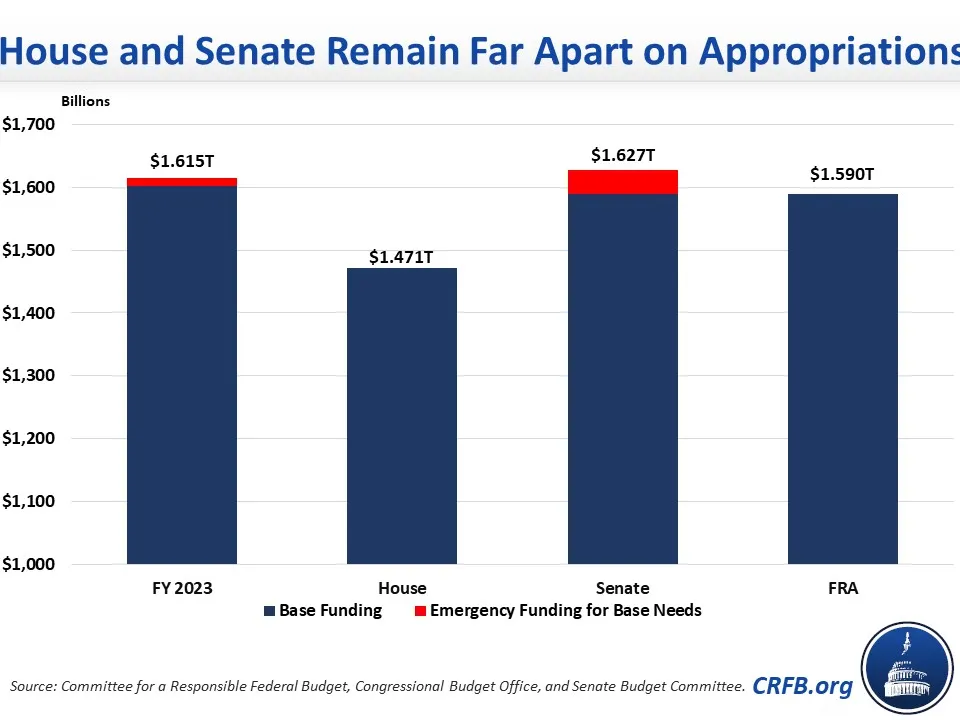Comparing 2024 Appropriations Levels
With the passage of the second continuing resolution (CR) for Fiscal Year (FY) 2024, Congress should turn to passing full-year appropriations bills. Under the so-called "laddered" approach for the second CR, funding is currently slated to expire on January 19 for four appropriations bills and on February 2 for the remaining eight. So far, the House has passed seven appropriations bills, while the Senate has passed three. Unfortunately, the two chambers remain far apart, and neither is spending at the levels agreed upon under the Fiscal Responsibility Act (FRA).
In this piece, we show that:
- Neither the Senate nor the House are sticking to the agreed-upon discretionary levels in the FRA.
- The Senate is planning to spend about $37 billion above the FRA and $14 billion above what was reportedly agreed to under "side deals."
- The House is planning to spend $119 billion below the FRA, though much of the difference is the result of one-time rescissions.
- Both chambers are relying on additional rescissions and phony spending cuts – some part of the FRA "side deals" – to increase the gross amount of funding appropriated.
The FRA capped FY 2024 base discretionary spending at $1.590 trillion, slightly below FY 2023 base levels. In particular, the FRA boosted defense spending by about 3 percent and reduced base nondefense spending by 5 percent.1 Alongside the FRA, policymakers reportedly agreed to several "side deals" that would allow them to cover about $46 billion (up from $15 billion in 2023) of nondefense costs through a variety of rescissions and budget gimmicks and designate an additional $23 billion of ordinary nondefense spending as "emergency" (up from $13 billion in 2023).2
However, neither House nor Senate appropriators have thus far stuck to the agreed-upon levels in either the FRA or the FRA with side deals. In the House, appropriators set topline funding levels at the FY 2022 level – $1.471 trillion for base funding – which is $119 billion below the official FRA levels. Meanwhile, the Senate is working to appropriate $1.627 trillion, which is $37 billion above the FRA levels. Not only are Senate appropriators employing all of the "side deal" tactics, but they have also added an additional $13.7 billion of phony emergency spending to help cover base funding costs for both defense and nondefense.

Overall, the House is appropriating 7.5 percent below the FRA levels, while the Senate is 2.3 percent above the FRA levels. This does not account for various rescissions and phony spending cuts, which would bring the House's effective spending levels closer to the FRA and the Senate's further above it.
Apart from the topline funding levels and emergency differences, the House and Senate are also very far apart on 302(b) allocations for each of the appropriations bills. For example, the Senate provides 46 percent more than the House on Agriculture, about 49 percent more each on Financial Services-General Government and Interior-Environment, over 41 percent more on State-Foreign Operations, nearly 33 percent more on Labor-HHS-Education, and 35 percent more on Transportation-HUD. The House and Senate are closest on levels for Defense, Military Construction-VA, and Legislative Branch.
How Close are FY 2024 Appropriations Levels?
| Appropriations Subcommittee | FY 2023 Omnibus | House | Senate |
|---|---|---|---|
| Agriculture | $25.5B | $17.8B | $26.0B |
| Commerce-Justice-Science | $82.4B | $58.7B | $69.6B |
| Defense | $797.7B | $826.4B | $823.3B |
| Energy-Water | $54.0B | $52.4B | $56.7B |
| Financial Services | $27.6B | $11.3B | $16.8B |
| Homeland Security | $60.7B | $62.8B | $56.9B |
| Interior-Environment | $38.9B | $25.4B | $37.9B |
| Labor-HHS-Education | $207.4B | $147.1B | $195.2B |
| Legislative Branch | $6.9B | $6.7B | $6.8B |
| Military Construction-VA | $154.2B | $155.7B | $154.4B |
| State-Foreign Operations | $59.7B | $41.4B | $58.4B |
| Transportation-HUD | $87.3B | $65.2B | $88.1B |
| Total, Base Funding | $1,602B | $1,471B | $1,590B |
Sources: Senate Appropriations Committee, House Appropriations Committee, Congressional Budget Office, and Committee for a Responsible Federal Budget.
Note: Numbers may not add due to rounding.
Despite being nearly two months into the fiscal year, lawmakers seem no closer on an agreement to fund the government for the entirety of FY 2024. Both chambers should abandon their current approaches and stick to the levels agreed to in the FRA, funding the government with certainty for the rest of the fiscal year.
1 These percentage changes are compared to the amounts at which CBO originally scored appropriations bills; actual base NDD in FY 2023 was higher than scored due to CHIMPs, rescissions, and offsetting receipts. All figures in this piece are compared to the CBO-scored FY 2023 appropriations. Compared to total gross spending in FY 2023, strictly abiding by FRA caps would require an 8 percent reduction to nondefense discretionary levels for FY 2024.
2This brings the total amount of "side deals" for FY 2024 to roughly $69 billion, which is about $41 billion above what was done in FY 2023.

